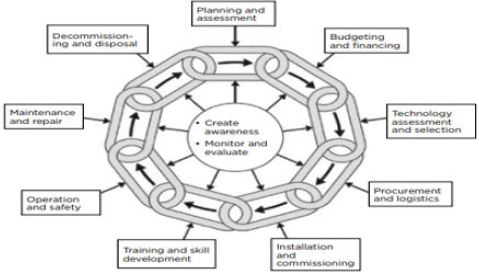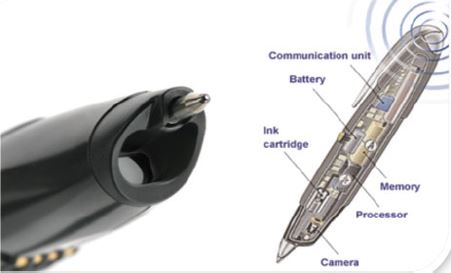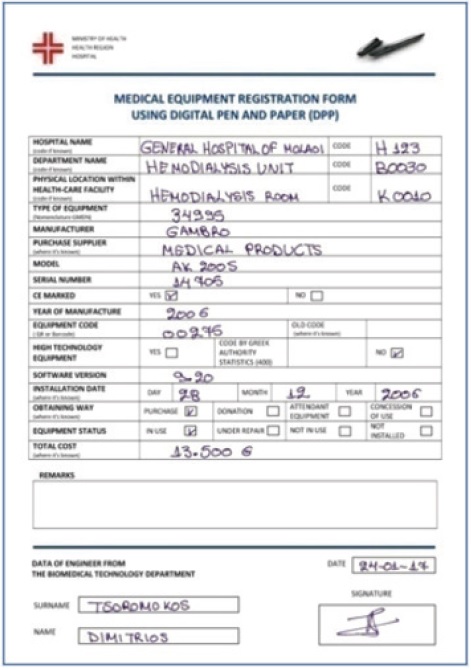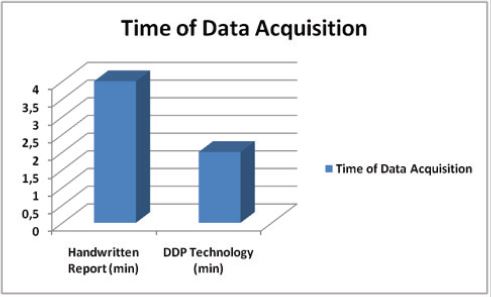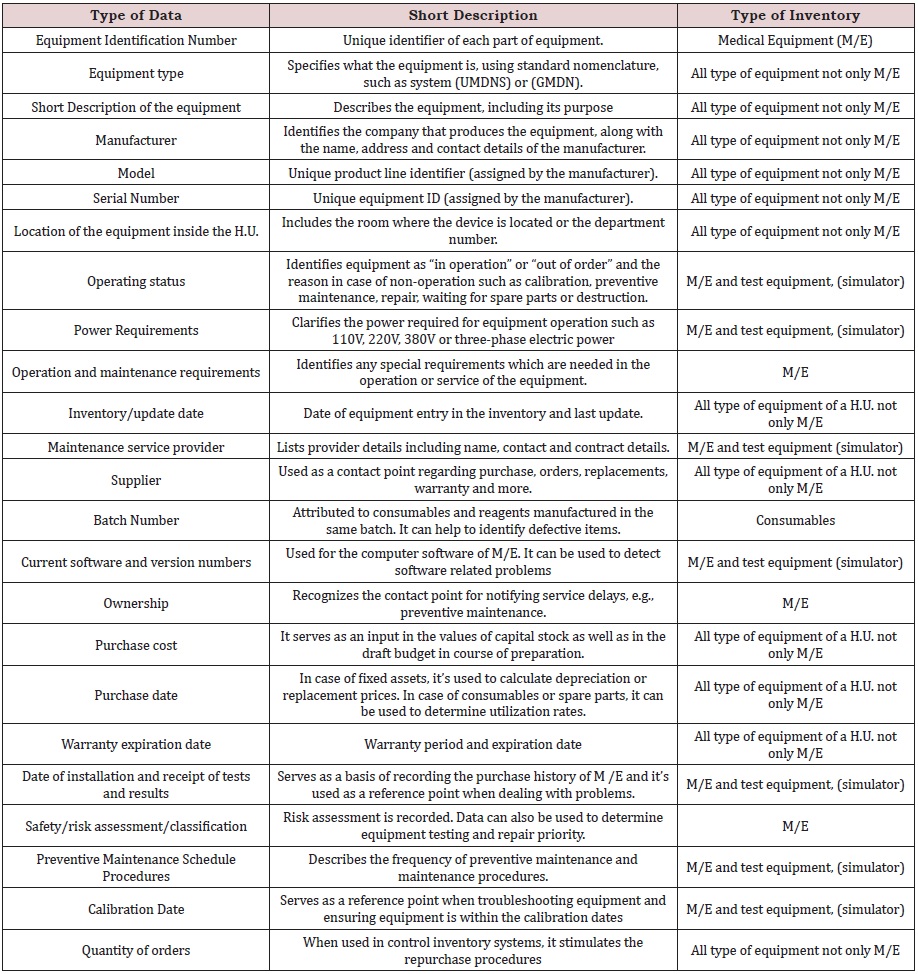Adoption of Digital Pen and Paper Technology (DPP) in Biomedical Technology
ABSTRACT
In recent years, Health Information Management Systems are integrated in Information and Communication Technologies (ICT) in order to ensure that the effectiveness and efficiency of Health Units (H.Us) are improved. The use of major Medical Equipment (M/E) in Hospital Units is necessary for achieving the best possible treatment. Digital Pen and Paper technology (DPP) is a useful ICT tool that aims to enhance the electronic registration and management of Medical Equipment of Biomedical Technology (BIT) Departments. DPP application can help to upgrade the quality of public health services, reorganize and simplify the internal medical processes and save time and costs during the daily nursing practices. Furthermore, DPP technology also promotes a better assessment and management of public health services with full transparency of financial procedures by using real-time monitoring of Medical Equipment. It can also be used for the improvement of accountability procedures of both Health Professionals & Biomedical Engineers, as well as the design of effective health financial policies.
KEYWORDS
Digital pen and paper; DPP technology; Process automation; Data digitization; Medical equipment; Financial management
INTRODUCTION
Health technology has become a critical component of healthcare, as it enables Health Professionals to provide diagnosis, treatment, monitoring and treatment to patients within an appropriate care environment. Quality management of health technologies helps to ensure that these services are provided in a safe and efficient manner [1]. The first step in managing health technology is to determine what data needs to be managed in order to conduct the inventory of medical equipment or otherwise to create a digital platform for the management of medical equipment on order to ensure better diagnosis and health treatment [2]. The inventory is a working document that is updated at regular intervals in order to inform users and medical professionals about the accuracy of their operating equipment [3]. When used properly, the inventory serves as an important and powerful tool for improving the management of key aspects of health technology [4]. It is important to understand that maintaining an accurate record is not the end of the Medical Equipment Management process [5]. Instead, the inventory serves as data input to many different activities of Healthcare Technology Management Cycle [6,7]; (Figure 1). The digital platform of Medical Equipment (M/E) of Hospital Units (H.Us) requires information that is collected by the suppliers’ equipment including the contract details entered at the time of purchase. It also requires data which is collected by the online equipment registration in the respective places that is located especially during Covid-19 pandemic [8- 12]. The registration of M/E is carried out by specialized staff of Biomedical Technology (BIT) engineers who are usually members of the Department of Biomedical Technology (DBIT) of a H.U. DBIT in collaboration with the Clinics and the Administration of the H.U. (supply office, file of contracts etc.) records the M/E. Registration requires the assignment of a login code of each part of the equipment, the creation and maintenance of a digital file that contains specific information of each device [13].
Table 1 presents a list of information that follows an ascending order of significance. The entries at the top of the table give the least general information. At the bottom of the table there is more specific data.
The digital platform of M/E should not only be a static record of information but also a dynamic and functional tool of managing and supporting decision making [14-17]. Therefore, it should support the respective services of both the administration and the individual health units.
MATERIAL AND METHODS
In order to develop the digital platform for conducting the inventory of medical equipment, we have used Digital Pen & Paper Technology (DPP technology) that was developed in the Digital Health Applications and Health Economics Analytics Laboratory of University of Peloponnese (DigiTHEA Lab). The DPP application operates on a simple web-based platform and helps users to edit, manage, import, and export any written document in digital form. The application entails user roles (Administrator, Printer, Designer, Viewer, Clerk) and users can operate both a digital pen and a tablet. The digital pen launched by Anoto consists of (Figure 2):
a) A light bulb that emits infrared radiation accompanied by
a small-sized image sensor
b) A Bluetooth communication device and a memory storage
media
c) A processor and a battery.
Data that is saved in the memory storage media can wirelessly be transferred by using a Smartphone’s Bluetooth device or a usb stick operating on “Pen Pusher” software. Memory unit can store up to 200 A4 pages/forms namely 40 A4 full manuscripts without digital pen connection for sending data and before battery charge [18-21]. The exact location of the pen, the kind of data edited, the editing time (timestamp), the user ID, as well as the kind of paper used can be precisely spotted by each digital image.
By using the so-called “Design Tool” application, the digital field zoning on the standardized form is performed. The existing form can be designed from scratch, depending on the requirements of the service. The next step is registration language setting in all fields. The 2.13 version supports over 30 languages and has access to 9 alphabets. The handwritten imprint takes place in single-line, multi-line, or boxed fields and include date, time, a checkbox, a drawing area and the signature area. The drawing area and the signature area are not edited, and they are saved as an image digital file. The other fields are converted into digital characters, supported by Optical Mark Recognition (OMR) & Optical Character Recognition (OCR) software and they are saved as well. The digital file is downloaded in the “Design Tool” application and it can be exported as .xml, .csv, .pdf, or. textual pdf file. The file receiver can either be the person that uses the digital pen himself or the person who owns Viewer or Clerk rights. It can also be sent as an email message and it can be uploaded on the “Formidable Viewer” application, which enables the final inspection of the form. Finally, data acquisition takes place by the central data acquisition center of the Hospital Unit. The dot pattern consists of small black dots printed in intervals of 0.3mm and can be printed on any type of paper by using various printing techniques, including offset, laser and inkjet printing (Figure 3). The layout of the pattern can be used as a unique identification location code on the paper. Both the pattern and the image sensor located on the tip of the pen, enable Anoto system to record and transmit accurately everything is written in 60 million square kilometers in Anoto pattern [22-24].
Finally, the designed standard form is an A4-sized paper (210 x 297mm) which has been developed by studying the existing documents of BIT departments, the standard documents used by Ministry of Health and Solidarity and the needs of clinical technicians. The medical equipment registration form is based on the Digital Pen and Paper application (DPP) and consists of 22 single-line fields, 1 multi-line field, 1 date field, 12 checkboxes, as well as 1 signature area. In Figure 4, a handwritten document (pdf) is illustrated, and in Figure 5, the conversion of a document into a digital form is performed. The document is filled in by the clinical technicians of Health Care Units.
RESULTS
A successful pilot test was conducted for three months at a Greek H.U. in Peloponnese using DDP technology. The technicians and nursing staff had been asked to use DDP technology in order to perform specific tasks such as:
A. Medical Devices registration
B. Damage and repair report
C. Prevention of quality failures
Some data was acquired by staff interviewing the staff. The members of the DigiTHEA Lab performed an overall assessment report. The summarized results are the following (Figure 6&7):
a. There was an almost two times faster data acquisition by using DPP technology compared to handwritten forms (2 min compared to 4 minutes of DDP Technology)
b. Nursing staff earned almost their daily duty time to complete the necessary reports
c. More than 85% of the nursing staff reported that DDP technology and the digital platform was absolutely user-friendly (85,8% of DPP Technology compared to 4,2% of handwritten reports)
d. More than 85% of both the technicians and the nursing staff admitted that DPP technology helped them to perform their daily tasks with more confidence and less errors (85,4 % of DPP Technology compared to 4,6% of handwritten reports)
e. The Head of BIT Department confirmed that work efficiency was highly improved because of the quick completion of the forms inside and outside the Department (91% of Head Departments confirmed an improved work efficiency by using DPP Technology)
This pilot research has confirmed that data entry by using this digital pen is a very useful application that reduces the daily workflow. A number of procedures must be followed for the correct equipment handling and special knowledge is needed with regards to the successful system implementation and task coordination.
DISCUSSION
The proposed digital platform as well as DPP technology can strengthen the electronic registration and management of M/E of the BIT Departments of H.Us. It can also help to improve the quality of healthcare services especially during Covid -19 pandemic. The faster digital procedures of the proposed digital inventory can save medical professionals much time in order to deal with the treatment of Covid19 patients. At the same time, the proposed application can help managers to reorganize the internal processes inside the Intensive Care Units (ICUs).
Τhe utilization of the DDP application in the daily activities of the BIT Department will result in the transition to the direct digitization of the handwritten information. BIT forms will be immediately available in the central information system of the Ministry of Health and Social Solidarity (such as the fault announcement bulletin, M/E registration bulletin and the maintenance bulletin). Data will be routed directly, quickly and securely to authorized users for processing. This technology is ideal for all health procedures based on handwritten forms. The collection of useful statistics for analysis and export of indicators (such as equipment operation time, machine downtime, number of repeated repairs and total maintenance costs) helps significantly in making up the right decisions. Indicators and results can help stakeholders to develop specific policies and programs for saving costs of medical supplies during Covid-19 pandemic. They can also evaluate the effectiveness and have benchmarks on deciding which medical equipment is cost effective during Covid-19 pandemic e.g., respirators.
REFERENCES
- World Health Organization (2018) Delivering quality health services: A global imperative. OECD Publishing.
- Garg S, Williams NL, Ip A, Dicker AP (2018) Clinical integration of digital solutions in health care: an overview of the current landscape of digital technologies in cancer care. JCO Clinical Cancer Informatics 2: 1-9.
- Avizenna MH, Widyanto RA, Wirawan DK, Pratama TA, Nabila AS (2021) Implementation of apriori data mining algorithm on medical device inventory system. Journal of Applied Data Sciences 2(3): 55-63.
- (2011) Introduction to medical equipment inventory management WHO Medical device technical series.
- Chen Y, Ding S, Xu Z, Zheng H, Yang S (2019) Blockchain-based medical records secure storage and medical service framework. Journal of Medical Systems 43(1): 5.
- Hegarty F, Amoore J, Blackett P, McCarthy J, Scott R (2017) Healthcare technology management- A systematic approach. CRC Press, USA.
- Baretich MF (2017) Healthcare technology management: A systematic approach. Biomedical Instrumentation & Technology 51(2): 169-169.
- Khodadadi V, Bakrani A, Vafaie MH (2021) Factors affecting medical equipment management in the COVID-19 pandemic crisis: A mixed qualitative & quantitative study. Hospital Practices and Research 6(1): 23-28.
- Huang E (2021) A multi-platform information management system of total life cycle for medical equipment. Global Clinical Engineering Journal 4(1): 8-16.
- Ten Haken I, Allouch SB, Van Harten WH (2020) Reporting incidents involving the use of advanced medical technologies by nurses in home care: A cross-sectional survey and an analysis of registration data. BMJ Quality & Safety 30(5): 380-387.
- Schaum KD (2020) Modifier tips for physicians who submit their own claims for durable medical equipment, prosthetics, orthotics, and supplies. Advances in Skin & Wound Care 33(8): 401-402.
- Bergman L, Falk AC, Wolf A, Larsson IM (2021) Registered nurses’ experiences of working in the intensive care unit during the COVID‐19 pandemic. Nursing in Critical Care 26(6): 467-475.
- Chunkhare M, Jadhav D, Ghare A, Ghare V (2020) Designing and developing a computerized biomedical equipment’s inventory management system. Recent Advances in Science and the Coronavirus PA, p. 91.
- Nebeker C, Bartlett Ellis RJ, Torous J (2020) Development of a decisionmaking checklist tool to support technology selection in digital health research. Translational Behavioral Medicine 10(4): 1004-1015.
- Sleurs K, Seys SF, Bousquet J, Fokkens WJ, Gorris S, et al. (2019) Mobile health tools for the management of chronic respiratory diseases. Allergy 74(7): 1292-1306.
- Krausz M, Westenberg JN, Vigo D, Spence RT, Ramsey D (2020) Emergency response to COVID-19 in Canada: platform development and implementation for eHealth in crisis management. JMIR Public Health and Surveillance 6(2): e18995.
- Wang WT, Wu SY (2021) Knowledge management based on information technology in response to COVID-19 crisis. Knowledge Management Research & Practice 19(4): 468-474.
- World Health Organization (2019) Delivering quality-assured medical products for all 2019-2023: WHO’s five-year plan to help build effective and efficient regulatory systems. No. WHO/MVP/RHT/2019.01.
- Shaballout N, Neubert TA, Boudreau S, Beissner F (2019) From paper to digital applications of the pain drawing: Systematic review of methodological milestones. JMIR mHealth and uHealth 7(9): e14569.
- Tran C, Dicker A, Leiby B, Gressen E, Williams N, et al. (2020) Utilizing digital health to collect electronic patient-reported outcomes in prostate cancer: Single-arm pilot trial. Journal of Medical Internet Research 22(3): e12689.
- Rosengren C (2018) Adapting reality to the matrix: Digital technology in social home care. Digital Age, p. 43.
- Persson HL, Lyth J, Wiréhn AB, Lind L (2019) Elderly patients with COPD require more health care than elderly heart failure patients do in a hospital-based home care setting. International Journal of Chronic Obstructive Pulmonary Disease 14: 1569-1581.
- Cruz VM, Pulmano CE, Estuar ME (2020) Towards an on-line handwriting recognition interface for health service providers using electronic medical records. HEALTHINF20-RP-31, pp. 383-390.
- Chantziaras I, De Meyer D, Vrielinck L, Van Limbergen T, Pineiro C, et al. (2020) Environment-, health-performance-and welfare-related parameters in pig barns with natural and mechanical ventilation. Preventive Veterinary Medicine 183: 105150.
Article Type
Research Article
Publication history
Received Date: February 04, 2022
Published: February 16, 2022
Address for correspondence
Dimitrios Zarakovitis, Department of Economics, University of Peloponnese, Greece
Copyright
©2022 Open Access Journal of Biomedical Science, All rights reserved. No part of this content may be reproduced or transmitted in any form or by any means as per the standard guidelines of fair use. Open Access Journal of Biomedical Science is licensed under a Creative Commons Attribution 4.0 International License
How to cite this article
Tsoromokos D, Zarakovitis D, Lazakidou A. Adoption of Digital Pen and Paper Technology (DPP) in Biomedical Technology. 2022- 4(1) OAJBS.ID.000399.
Figure 1: Healthcare technology management cycle [1].
Figure 2: Parts of digital pen and paper technology (DPP).
Figure 3: Dots pattern of DPP technology.
Figure 4: Handwritten text (.pdf).
Figure 5: Text conversion in digital form (.pdf).
Figure 6: Faster data acquisition time by using DPP Technology.
Figure 7: Data of DPP Technology compared to handwritten inventory of medical equipment.
Table 1: List of medical inventory details [1].


